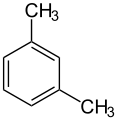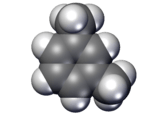m-Xylene
| |||
| Names | |||
|---|---|---|---|
| Other names
m-Xylol 1,3-Dimethylbenzene | |||
| Identifiers | |||
| 108-38-3 | |||
| ChEBI | CHEBI:28488 | ||
| ChEMBL | ChEMBL286727 | ||
| ChemSpider | 7641 | ||
| |||
| Jmol-3D images | Image Image | ||
| KEGG | C07208 | ||
| PubChem | 7929 | ||
| RTECS number | ZE2275000 | ||
| |||
| UNII | O9XS864HTE | ||
| Properties | |||
| C8H10 | |||
| Molar mass | 106.16 g/mol | ||
| Appearance | Colorless liquid | ||
| Density | 0.86 g/mL | ||
| Melting point | −48 °C (−54 °F; 225 K) | ||
| Boiling point | 139 °C (282 °F; 412 K) | ||
| insoluble | |||
| Solubility in ethanol | very soluble | ||
| Solubility in diethyl ether | very soluble | ||
| Refractive index (nD) |
1.49722 | ||
| Viscosity | 0.8059 cP at 0 °C 0.6200 cP at 20 °C | ||
| Dipole moment | 0.33-0.37 D[1] | ||
| Hazards | |||
| MSDS | External MSDS | ||
| Main hazards | Harmful or fatal if swallowed. Vapor harmful. Flammable liquid and vapor. | ||
| R-phrases | R10 R20 R21 R38 | ||
| S-phrases | S25 | ||
| NFPA 704 | |||
| Flash point | 25 °C | ||
| Explosive limits | 1.1%-7.0%[2] | ||
| US health exposure limits (NIOSH): | |||
| PEL (Permissible) |
TWA 100 ppm (435 mg/m3)[2] | ||
| Related compounds | |||
| Related aromatic hydrocarbons |
benzene toluene o-xylene p-xylene | ||
| Supplementary data page | |||
| Refractive index (n), Dielectric constant (εr), etc. | |||
| Thermodynamic data |
Phase behaviour solid–liquid–gas | ||
| UV, IR, NMR, MS | |||
| Except where noted otherwise, data is given for materials in their standard state (at 25 °C (77 °F), 100 kPa) | |||
| | |||
| Infobox references | |||
m-Xylene (or meta-xylene) is an aromatic hydrocarbon, based on benzene with two methyl substituents. It is an isomer of o-xylene and p-xylene. The m stands for meta, meaning the two methyl substituents are at locants 1 and 3 on the aromatic ring. m-Xylene is commonly produced in BTX processes, and separated as needed from the other aromatic hydrocarbons.
The major chemical use of meta-xylene is in the manufacture of isophthalic acid, which is used as a copolymerizing monomer to alter the properties of polyethylene terephthalate (PET), making PET more suitable for the manufacture of soft drinks bottles. To convert m-xylene on an industrial scale to isophthalic acid, the two methyl groups are both catalytically oxidized to carboxyl groups. It is also used as a raw material in the manufacture of 2,4- and 2,6-xylidine as well as a range of smaller-volume chemicals.[3]
References
- ↑ DeanHandb, Lange´s Handbook of chemistry, 15th edition,1999.
- ↑ 2.0 2.1 "NIOSH Pocket Guide to Chemical Hazards #0669". National Institute for Occupational Safety and Health (NIOSH).
- ↑ Ashford's Dictionary of Industrial Chemicals, third edition, page 9692.


